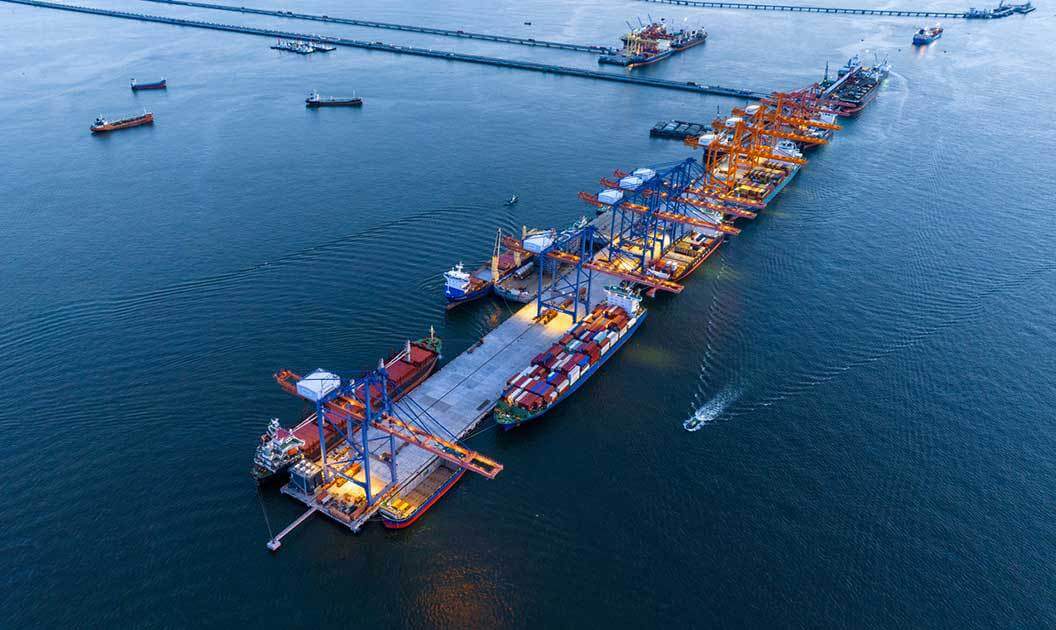
International cargo shipping rates can strike fear into exporters. With so many factors affecting the cost of sending goods overseas, it can be difficult to navigate the complex world of international transport, while also keeping expenses under control.
According to the World Bank, international transport rates account for a large portion of the total amount of goods. International cargo shipping is a term that refers to the cost of sending goods to another nation. Rates are determined by various factors that exporters will have to be aware of when sending their freight overseas.
It’s important for businesses to understand international cargo shipping rates to manage logistics expenses. We have the information to help you accomplish this.
International cargo shipping rates are the charges that exporters incur when they ship their goods to another country. Organizing loads of freight to be sent overseas requires much preparation and a vehicle for transport. There are two forms of shipping that exporters typically use.
These include:
Each of these modes of transportation will come with unique costs. We’ve provided data that shows the rates for international air and ocean freight shipping.
| Air | Ocean |
| $3.00-$7.00 per-kilogram | $1,740.26 Per-Full Container Load (FCL) |
Provided by Freightos and Statista
While international air might seem more like the cheaper option, ocean transport allows shippers to send more freight at once. This makes moving freight by vessel a more cost effective-option.
If a shipper wants to send a less-than container load (LCL), the rate they pay will be based on the weight or volume of the freight. Depending on which is higher will determine what the carrier charges. Since every LCL shipment is different, providing an exact rate is difficult to do.
International air cargo shipping rates are typically more expensive than ocean freight rates. Fortunately, there are many benefits of using this transportation service that offset these costs.
Some advantages include:
Air shipping is the fastest mode of transportation for international shipments. A package that would take weeks to arrive by ocean freight can arrive in just a few days by air. Air shipping is generally more reliable than other modes of transportation due to the frequency of flights and the ability to track loads in real-time.
International freight movements by plane can be a more flexible option for businesses that need to send goods quickly and on short notice. Air carriers can often accommodate last-minute requests for shipping services. Transport via plane can also provide exporters with more cargo security for high-value or sensitive goods. Airports have strict security measures in place to prevent theft and damage.
For many shippers, these advantages offset the high expenses and other disadvantages that come with this transportation option.
Disadvantages of shipping by air include:
As mentioned, air shipping is an expensive option for exporters. This is due to the high fuel costs associated with plane transportation. Aircraft also have limited cargo capacity, which can result in higher rates during periods of increased demand.
Additionally, cargo aboard a plane can be subjected to restrictions based on:
Many of these restrictions are enforced by the Federal Aviation Administration (FAA). These regulations not only increase rates, but severely limit the variety of goods you can transport. Considering the potential disadvantages of shipping by plane can help businesses determine if this mode of transport is the right choice for their particular shipment.
International ocean freight prices are typically less expensive than air cargo rates. However, there are some other benefits that come with this service.
Some advantages of ocean freight shipping include:
Ocean freight transport is generally more cost-effective than air shipping, especially for large quantities of goods that aren’t time-sensitive. Ocean vessels have much larger cargo capacity than airplane. This makes overseas transport a more practical option for businesses that need to move large quantities of goods.
Ocean carriers have more flexibility in terms of the type of cargo they can carry and the ports they can access. Therefore, vessel transport is a better option for businesses that need to transport a wide range of goods. While ocean shipping is slower than air, it’s generally more reliable due to the frequency of voyages and the ability exporters have to track shipments in real-time.
Despite the several advantages for ocean provides businesses, there are also some potential drawbacks exporters have to consider.
Some include:
Overseas transport can take weeks and sometimes months to arrive at a destination. Ocean shipping is also more susceptible to delays due to inclement weather. This further impacts delivery times and increases the risk of cargo damage.
Delays at ports and along shipping lanes can also occur. Despite the cheapness of international ocean freight rates, these interferences can wreak financial havoc on exporters. Higher costs will occur if freight requires specialized equipment and handling.
Vessel transport can be vulnerable to piracy and other security concerns, which can increase the risk of cargo loss or damage.

There are many factors that can affect international shipping rates. By understanding what factors can influence these costs, exporters can work to optimize their shipments and reduce overall shipping costs.
While planes offer a convenient way to send goods to other countries, several factors can impact international air cargo shipping rates.
Some factors include:
While convenient, air transportation isn’t a cheap service. Planes consume a considerable amount of fuel while traveling from one country to another. The distance of a shipment can also impact international air rates.
Generally, longer routes will result in higher shipping costs. Certain destinations are also more expensive, either due to local regulations or based on popularity. If the destination is a location where a flight is unlikely to pick up more cargo, they will charge more to off set the fuel costs.
The weight and volume of air cargo also impacts shipping rates. Generally, the heavier and bulkier the freight, the more expensive it will be to transport.
Depending on the service required, travel via plane can be more costly than the standard shipment. Expedited services, for example, are more costly than regular air shipments due to the time constraints placed on a shipment. Some options, like port to porth shipping, are a cheaper alternative if you have the logistics system in place to handle pre-carriage and post-carriage.
Market supply and demand can also play a significant role in international cargo rates. When there is a strong need for air transport, carriers may increase the amount they charge for their services. Conversely, carriers may lower their costs to attract more customers when demand is lower.
Each of the factors we discussed can cause international air cargo shipping rates to rise or fall. Exporters will have to assess them carefully to determine their costs.
If you’re worried about expenses, consider freight forwarding Incoterms® to help reduce costs.

Ocean freight rates are a crucial consideration for businesses that rely on this transportation option to move their cargo. Sea freight costs are much cheaper than the rates associated with international air travel.
Ocean transport is also the most commonly used method to move goods internationally. There are some routes more expensive than others. To demonstrate this, we’ve provided some important data to consider.
| Trade Route | Average Rate(Per FCL) |
| Trans-Pacific | $1,126 |
| Panama Canal | $1,781 |
| Transatlantic | $1,397 |
Provided by Freightos and GoComet
These statistics show that while transport overseas is a popular option, it’s one where shippers still need to monitor rates.
Sea shipping rates rarely stay the same and can fluctuate due to various reasons.
The type of freight being shipped can impact cargo ship freight rates. For example, refrigerated cargo may be subject to higher rates due to the specialized handling and equipment. The size of a container can also impact ocean cargo rates. Larger ones may be subject to higher rates due to the increased handling.
Where the shipment is sent from and the final destination can sway ocean freight prices. Freight that’s transported to or from remote areas may be subject to higher container ship rates due to limited infrastructure and higher transportation costs.
Seasonal demand can also impact ocean cargo shipping prices. Rates are higher during the months leading up to the holiday season and other peak operation times throughout the year. Fuel costs also influence international sea freight prices. If the cost of fuel rises, so will the rates for ocean shipping costs.
Market supply and demand can also play a significant role in ocean freight shipping costs, with rates increasing when the need for shipping services is high and carriers have limited capacity. Businesses should consider these factors carefully to determine when sea freight shipping costs are the lowest.

Exporters can easily go over budget with international air cargo shipping rates and ocean freight prices if they aren’t being careful. Reducing international transport costs is a top priority for businesses that need to move their products across borders.
Fortunately, there are a few ways exporters can lower their rates:
We’ll show you how to use each of these strategies to reduce international air and sea freight rates.
One of the best ways to reduce international cargo shipping costs is to negotiate lower rates with carriers and other logistics providers.
During negotiations, exporters should try discussing some of the following:
Consolidation can help exporters take advantage of bulk rates and reduce their shipping costs. Businesses can also negotiate long-term contracts with carriers and logistics providers, which can result in lower rates and improved service over time.
Another way to negotiate lower costs is to leverage volume discounts. Businesses that ship large quantities of goods on a regular basis might be given this option. Negotiating favorable payment terms can also help exporters reduce their shipping costs.
Another way for businesses to reduce their international cargo shipping rates is to optimize their packaging and shipping processes.
Some ways to do this include:
Standardized packaging can help businesses reduce their transportation costs by ensuring that their shipments are as compact and space-efficient as possible. Using lightweight materials can also help businesses reduce their rates by lowering the weight of their shipments.
Choosing the appropriate shipping methods can also help businesses bring their costs down. For example, larger shipments should travel via ocean, while smaller and time sensitive shipments should be sent via air. Maximizing container space by stacking goods efficiently and using all available space can help businesses reduce their shipping costs by reducing the number of containers required.
There are eight different types of ocean containers that exporters can utilize. Minimizing shipping distance can also help businesses reduce their shipping costs. This can be done by sending goods directly to the destination instead of through multiple ports
Exporting international freight as a full container load (FCL) is an option that many shippers choose. Our article on the benefits of FCL will show you why you should ship your goods with this option.
Many exporters utilize various software and logistics systems to manage their international shipments. Businesses can reduce their international cargo shipping rates by leveraging these programs.
Advances in technology have led to:
TMS software can help exporters optimize their shipping routes, track their shipments in real-time, and reduce their transportation costs. WMS software is another option can help businesses.
This type of technology can:
EDI systems assist exporters by automating their data exchange processes, such as order processing and shipment tracking. Freight forwarding software is used by exporters who want to manage their shipments more effectively.
This type of program can help with:
Real-time data analytics can help businesses analyze their supply chain operations in real-time, identify areas for improvement and make data-driven decisions to reduce their shipping costs.
At USA Freight Forwarding, we help businesses manage their international shipping needs. We provide a variety of services that you’ll find useful when you need to send an international shipment to another country.
The resources we provide include:
From ocean freight shipping to international air shipping, we have the expertise and experience to handle any load cargo. Additionally, our consulting services can help businesses with their export responsibilities.
If you’re interested in learning more about how USA Freight Forwarding can help your business reduce its international cargo shipping rates, then contact us today at (866) 941-8081. You can also go to our contact page to communicate your questions and concerns.
